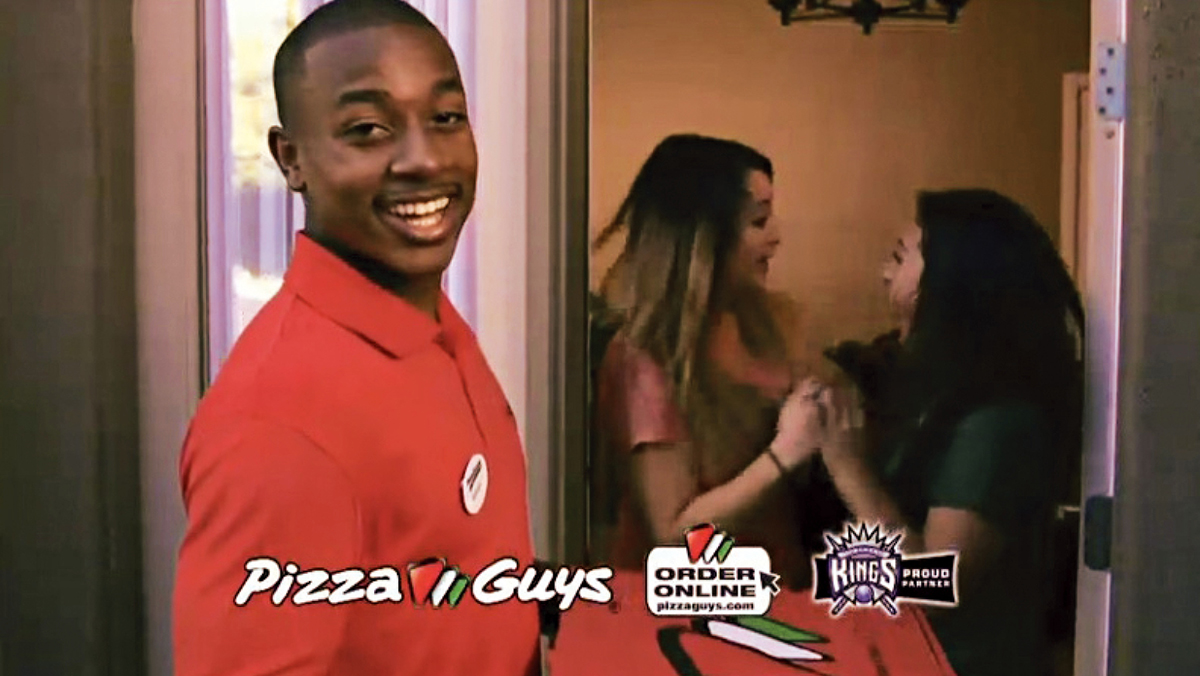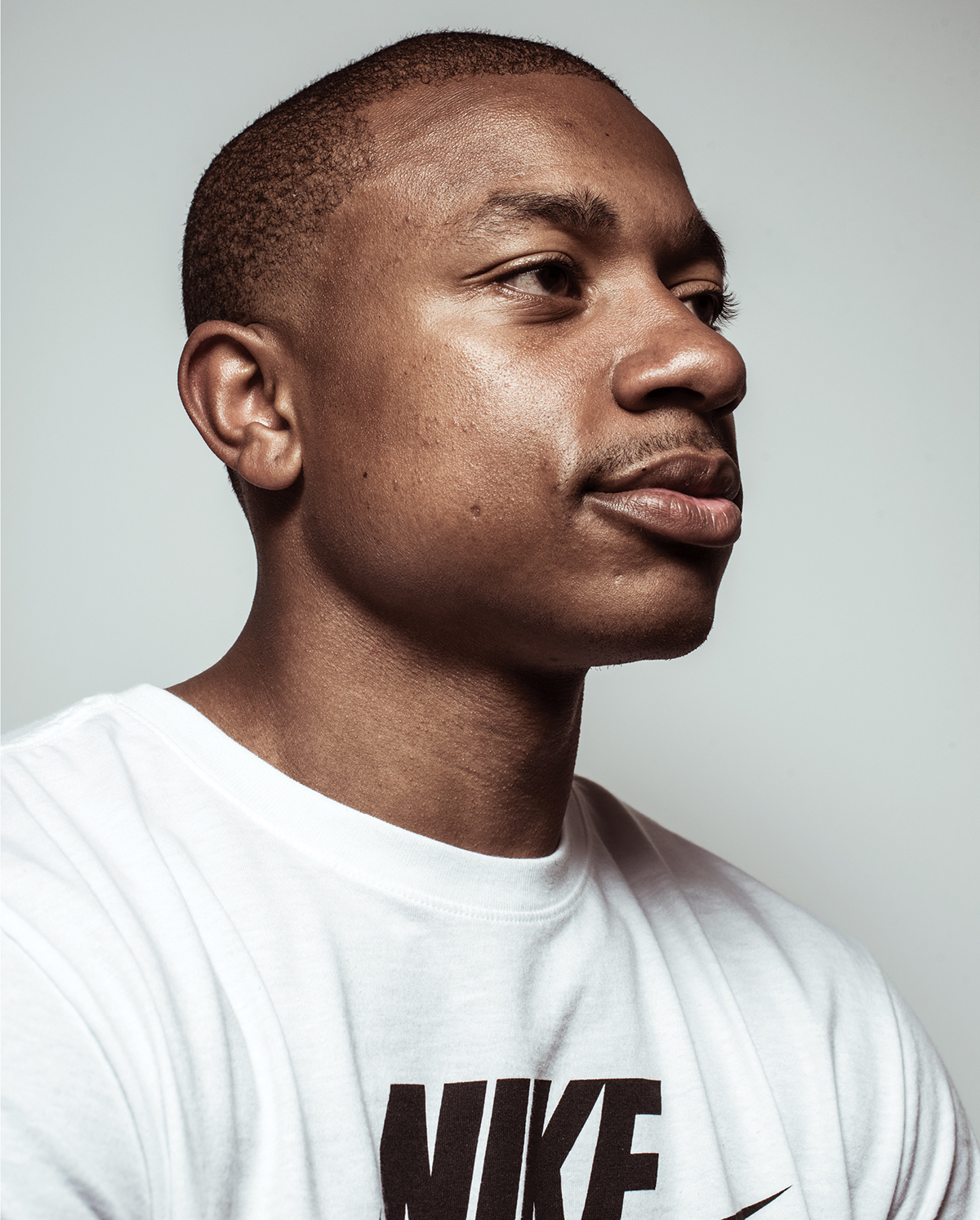Isaiah Thomas: The Biggest Little Man in Boston

Before joining the Celtics, Thomas gained notice for his Pizza Guys ads in California.
Unlike James’s rookie $90 million contract with Nike, Thomas’s Pizza Guys deal didn’t shoot him to the top of any Forbes lists, but the ads helped make Thomas a cult favorite. Opponents began yelling, “What’s up, Pizza Guy?” and Thomas says All-Star center Dwight Howard even approached him and mentioned the ads.
His days as the Pizza Guy, though, were numbered. As part of a sign-and-trade deal in the summer of 2014, the Kings inked Thomas to his current contract and flipped him to the mediocre Phoenix Suns. He played limited minutes in only half a season as a backup with Phoenix, a club overloaded with small, quick guards, before his new team unceremoniously shipped him to Boston. For the second time in his life, Thomas stepped onto a flight to New England with hopes of saving his basketball career.
Thomas may have boarded a plane in sunny Phoenix, but he was greeted in Boston by the snowiest winter in city history. He quickly underwent a team physical and then FaceTimed with his new head coach, Brad Stevens. At first, Stevens wasn’t sure how to use the jetlike point guard. Would Thomas start or come off the bench? All Stevens knew was that Thomas’s career so far had been a bumpy road and that he was coming to town with something to prove. “That’s a powerful, powerful thing if that energy is funneled correctly,” Stevens says. “Here was a guy dying to win.”
Trading for Thomas didn’t pose much of a risk. Boston needed a scorer, it didn’t give away much in exchange, and Thomas’s contract didn’t break the bank. Plus, Danny Ainge, the president of basketball operations, had a longtime crush on the little guy. “I’ve always wanted Isaiah,” the usually cagey exec told the Herald after the trade. “Isaiah was my first call last summer in free agency.”
During Thomas’s first game with the Celtics, against the Lakers in February 2015, Stevens got his first glimpse of his new point guard’s intensity. Thomas scored 21 points in an overtime loss, but was ejected in the fourth quarter after arguing a foul call with a referee. Stevens wasn’t exactly pleased, but he understood where Thomas’s fierceness was coming from. “I don’t think reining that in is something coaches think a ton about,” Stevens says. “A guy with fire and passion’s a good thing.” It was exactly what Thomas wanted to hear. “When you have a coach that has confidence in you, that’s half the battle,” he says. “All the NBA is about is opportunity and confidence.”
In 21 games as a reserve with Boston during his first season, Thomas averaged 19 points and 5.4 assists. By the next year, he’d fought his way into the starting lineup.
To help sum up Thomas’s effectiveness last season, the refreshingly eggheaded Stevens points to usage rate (the percentage of a team’s possessions a player is involved in per 40 minutes) and assist-to-turnover ratio (the number of assists a player has for every turnover he commits). Only one NBA player with a usage rate as high as Thomas’s and at least six assists per game had a better assist-to-turnover ratio last season: perennial All-Star Russell Westbrook. Stevens calls Thomas’s numbers “off the charts” and makes a point to praise his ability to score late in games when it matters most.
By late January, around the time Thomas was named to the Eastern Conference All-Star team, Celtics fans wearing his No. 4 jersey began popping up all over TD Garden. It was, he says, “definitely a dream.”
Without much help on offense, Thomas managed to steer the young Celtics into the playoffs for the second year in a row. It was a short trip, though. In the first round, Boston lost to the Atlanta Hawks. Thomas led both teams in scoring and minutes played. In the locker room after the decisive sixth game, he was exhausted and sat with a towel over his head before tearfully addressing reporters. “This should hurt everybody,” he said at the time, “[and] we can come back next year even stronger.”

Despite losing in the playoffs last season, Thomas vowed to “come back next year even stronger.” / Photograph by Toan Trinh
It certainly hasn’t been all heartache. At his basketball clinic this summer, Thomas is eager to tell me about a recent trip, one that included another (albeit slightly more accomplished) former late-round draft pick by the name of Tom Brady. With several members of the Celtics organization, they’d traveled to the Hamptons to meet NBA superstar Kevin Durant in hopes of luring him to Boston. The pitch failed and Durant joined the Golden State Warriors, but getting the chance to hang out with the Super Bowl–winning Patriots quarterback still has Thomas geeking out. He wants me to know that some all-time-great athletes are “kind of assholes.” Not Brady. “The coolest dude I’ve ever met,” says Thomas, pointing to his cell phone. “We text to this day.”
In his voice I hear a hint of disbelief, acknowledgment of the surreal nature of his current success. For one thing, Thomas’s Pizza Guys days are over. He now endorses Nike and Slim Jim. Over the summer, Thomas married his longtime girlfriend, Kayla Wallace, with their two sons, James and Jaiden, by their side. Yet Thomas is still trying to outrun the doubters and the nagging qualifiers that remain glued to his 5-foot-9 frame. A recent Globe story listing Thomas among Boston’s best undersize athletes seemed to bring the point home: The Mount Washington–size chip on his shoulder remains intact and rarely out of view.
Almost on cue, this summer—in what’s become an off-season ritual during Ainge’s reign—NBA writers began slinging rumors of Ainge’s desire to deal for the kind of physically gifted superstar that someone Thomas’s size supposedly can never be. At this year’s draft, however, the man once nicknamed “Trader Danny” played it straight, using the third overall pick to select underhyped University of California freshman Jaylen Brown instead of dealing it away. When the selection was announced at the official Celtics draft party, disappointed fans hoping for a blockbuster trade booed.
Ainge’s inaction may have upset die-hards jonesing for the Big Three 3.0, but it’s left the Celtics with something their rivals lust after: flexibility. Even after Boston signed All-Star center Al Horford to a four-year, $113 million deal, the team’s roster remains the third youngest in the NBA and includes few expensive long-term contracts.
Heading into this season, the overachieving Celtics haven’t had to mortgage their future. For that, Thomas—whom former Sacramento coach Malone calls “one of the best guards in the NBA”—deserves a fair share of the credit. Of course, that doesn’t mean he’ll get as much as he likely deserves. “That’s the way it is,” Thomas says, “and that’s how it’s gonna be.”


